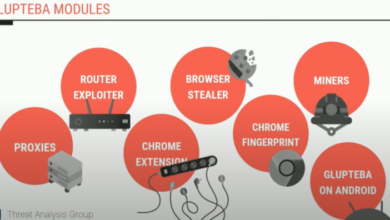
All Modern Computers Are Vulnerable to Cold Boot Attacks
All modern computers are vulnerable to cold boot attacks, a chilling reality that exposes the fragility of our digital security. These attacks exploit the lingering data in a computer’s RAM even after a power loss, allowing attackers to potentially extract sensitive information like encryption keys and passwords. Imagine the implications: a thief stealing your laptop, powering it down, and then later recovering your banking details.
This isn’t science fiction; it’s a real threat that affects every type of computer, from your personal laptop to massive corporate servers.
The persistence of data in RAM after a shutdown depends on several factors, including the type of RAM, ambient temperature, and even the speed of the subsequent boot process. Understanding these factors is crucial to comprehending the vulnerability and developing effective mitigation strategies. This vulnerability is further exacerbated by the increasing reliance on in-memory data processing, making sensitive information even more accessible during a cold boot attack.
Understanding Cold Boot Attacks
Cold boot attacks exploit the fact that data in a computer’s Random Access Memory (RAM) can persist for a short time even after the power is lost. This allows an attacker to gain access to sensitive information, such as cryptographic keys, passwords, and other confidential data, that would otherwise be erased during a normal shutdown. While modern systems employ various countermeasures, the vulnerability remains a significant concern, especially in situations where physical access to the target machine is possible.
The Mechanics of a Cold Boot Attack
A cold boot attack begins with the abrupt loss of power to the target computer. This could be achieved through various methods, from simply unplugging the power cord to more sophisticated techniques. Crucially, the sudden power loss doesn’t immediately erase all data from the RAM. Instead, the data persists in a degraded form due to the capacitor leakage within the RAM modules.
The longer the time since power loss, the more data degrades and becomes unrecoverable. An attacker, having physical access, then quickly boots the machine from a live Linux distribution or other specialized tools. Using specialized memory-imaging software, they can then capture the remnants of the data from the RAM before it completely dissipates. This captured data is then analyzed to extract the sensitive information.
Data Persistence in RAM After Power Loss
The survival of data in RAM after a power loss is due to the phenomenon of capacitor leakage. RAM chips use capacitors to store data as electrical charges. These capacitors gradually discharge after power is removed, but the process isn’t instantaneous. The rate of discharge is influenced by several factors, including the ambient temperature, the type of RAM, and the quality of the capacitors themselves.
The longer the data remains in the RAM, the more likely it is to be corrupted or become irretrievable. Specialized tools and techniques are employed to quickly access and image the RAM contents before significant data loss occurs. The window of opportunity for a successful attack is short and heavily influenced by the factors detailed in the table below.
Factors Influencing Data Persistence
The persistence of data in RAM after a system shutdown is a complex process influenced by multiple factors. Understanding these factors is crucial in mitigating the risk of cold boot attacks.
| Factor | Description | Impact on Data Persistence | Mitigation Strategy |
|---|---|---|---|
| Ambient Temperature | The temperature of the surrounding environment. | Lower temperatures generally lead to slower capacitor discharge, extending data persistence. | Maintaining a consistently higher ambient temperature in the server room or data center. |
| RAM Type | Different types of RAM (e.g., DDR3, DDR4) have different capacitor characteristics. | Some RAM types may exhibit longer data persistence than others. | Using RAM modules with faster discharge rates. Regular updates to the firmware of the system. |
| Capacitor Quality | The quality and age of the capacitors within the RAM modules. | Higher-quality capacitors generally lead to slower discharge. | Regular hardware maintenance and replacement of aging components. |
| Time Since Power Loss | The duration between power loss and data recovery. | Data persistence decreases exponentially with time. | Rapid response and data recovery procedures after a power outage. Employing robust and rapid power restoration systems. |
Vulnerability of Modern Computer Systems: All Modern Computers Are Vulnerable To Cold Boot Attacks
Cold boot attacks exploit the persistence of data in a computer’s RAM even after power loss. This vulnerability affects a wide range of modern computer systems, impacting both personal and enterprise environments. The susceptibility varies depending on factors like hardware, software, and operating system, creating a complex security challenge.The vulnerability of modern computer systems to cold boot attacks stems from the inherent properties of RAM and the limited countermeasures widely deployed.
Data in RAM, while volatile, retains its contents for a short period after power is removed, allowing attackers to recover sensitive information if they have physical access to the machine. This persistence window, while brief, is long enough to extract cryptographic keys, passwords, and other crucial data before it fully degrades.
System Types Susceptible to Cold Boot Attacks
Desktops, laptops, and servers are all susceptible to cold boot attacks. While desktops might be more easily secured due to their stationary nature, laptops are particularly vulnerable due to their portability and potential for theft. Servers, holding potentially sensitive organizational data, are high-value targets for such attacks, representing a significant security risk. The attack’s success depends less on the type of system and more on the attacker’s ability to gain physical access and perform the attack within the data retention window.
Hardware and Software Components Contributing to Vulnerability
The primary hardware component contributing to this vulnerability is the Random Access Memory (RAM). The persistence of data in RAM after power loss is the fundamental basis of the cold boot attack. Software components, particularly the operating system’s handling of memory and cryptographic keys, play a secondary but crucial role. Poorly implemented key management practices or insufficient encryption strength can exacerbate the vulnerability.
For example, the use of weak encryption algorithms or the storage of sensitive data unencrypted in RAM significantly increases the risk.
Operating Systems and Their Vulnerabilities
All common operating systems, including Windows, macOS, and various Linux distributions, are vulnerable to cold boot attacks. The specific vulnerability differs based on the operating system’s implementation of memory management and security features. While operating systems have improved their security over time, they haven’t fully eliminated the fundamental challenge posed by RAM data persistence. The window of opportunity for an attacker remains, even if shortened by improvements in hardware and software.
The effectiveness of countermeasures, such as full-disk encryption and sophisticated key management, depends heavily on their correct implementation and configuration.
Data at Risk from Cold Boot Attacks
Cold boot attacks exploit the persistence of data in a computer’s RAM even after power is lost. This means that sensitive information, which would normally be wiped clean, remains accessible for a short period, allowing attackers to extract it. The implications of this vulnerability are significant, impacting both individuals and organizations with varying degrees of severity.The window of opportunity for a cold boot attack is limited, typically measured in seconds or minutes depending on the type of RAM and environmental conditions.
It’s a scary thought: all modern computers are vulnerable to cold boot attacks, meaning sensitive data can be retrieved even after a system shutdown. This highlights the importance of robust security measures, and thinking about how we build secure applications. That’s why I’ve been diving into domino app dev, the low-code and pro-code future , exploring ways to develop more secure and efficient applications.
Ultimately, understanding these vulnerabilities is crucial, regardless of how we build our software, because the threat of cold boot attacks remains a significant challenge for all modern computer systems.
However, this brief window is often enough for a determined attacker to gain access to critical data. This makes understanding the types of data at risk and the potential consequences crucial for effective security planning.
Types of Sensitive Data Vulnerable to Cold Boot Attacks
A successful cold boot attack can compromise a wide array of sensitive data residing in a computer’s RAM. This includes information that is actively processed but not yet permanently stored on the hard drive. Examples include encryption keys used to protect files and communications, passwords stored in memory during login processes, and various other pieces of in-memory data like temporary files containing sensitive financial information or personally identifiable information (PII).
Even seemingly innocuous data, when pieced together, can create a comprehensive profile of an individual or organization, significantly increasing the risk. For instance, snippets of email drafts, temporary browsing history, or even recently accessed file paths can provide valuable intelligence to an attacker.
Potential Consequences of a Successful Cold Boot Attack
The consequences of a successful cold boot attack can range from minor inconvenience to catastrophic damage, depending on the nature of the compromised data and the target. The impact can be felt both on an individual level and at the organizational scale.
- High Severity:
- Complete Data Breach: Compromise of encryption keys could lead to the decryption and theft of sensitive data such as financial records, intellectual property, or confidential client information. This could result in significant financial losses, reputational damage, and legal repercussions. A real-world example would be a successful attack on a bank, leading to the theft of customer account details and funds.
- System Compromise: Gaining access to system passwords or authentication tokens could provide complete control over a system, enabling further attacks and data exfiltration. This is particularly damaging for critical infrastructure systems like power grids or financial networks.
- Medium Severity:
- Identity Theft: Access to PII, such as addresses, social security numbers, and credit card information, can lead to identity theft and financial fraud. This could result in significant financial and emotional distress for the victim.
- Espionage: Acquisition of sensitive business plans, research data, or strategic information could provide a competitive advantage to an attacker or compromise national security if targeting governmental systems.
- Low Severity:
- Privacy Violation: Exposure of personal browsing history or email drafts may lead to privacy violations, though generally less damaging than high-severity consequences.
- Minor Data Loss: Loss of temporary files or in-progress work might cause minor inconvenience but without significant long-term impact.
Mitigation Techniques and Countermeasures

Cold boot attacks represent a significant threat to data security, exploiting the persistence of data in RAM even after a system shutdown. Mitigating this risk requires a multi-layered approach encompassing both hardware and software solutions. Effective countermeasures aim to either reduce the window of vulnerability or render the extracted data unusable.
Hardware-Based Mitigation Strategies
Hardware solutions offer the most robust protection against cold boot attacks by directly addressing the persistence of data in RAM. One primary approach involves employing specialized hardware components designed to rapidly erase RAM contents upon power loss. This could include specialized memory chips with integrated erasure mechanisms or dedicated hardware controllers that initiate a secure erase process. Another approach focuses on the physical design of the system, minimizing the time it takes for RAM to lose its charge.
This can involve using specialized RAM modules with lower retention times or optimizing system power management to ensure faster power depletion. These hardware-based solutions offer the advantage of being transparent to the user and operating system, requiring no software modifications. However, the cost of implementing these solutions can be substantial, making them more suitable for high-security environments.
Software-Based Mitigation Strategies
Software-based countermeasures primarily focus on rendering extracted data useless. The most effective method is full-disk encryption. By encrypting the entire hard drive, including swap space and hibernation files, even if data is recovered from RAM, it remains unreadable without the correct decryption key. Additionally, implementing strong password policies and multi-factor authentication can further strengthen security. Software solutions are generally less expensive to implement than hardware solutions, but their effectiveness depends on the proper configuration and user adherence to security best practices.
The reliance on software also introduces the possibility of vulnerabilities in the software itself, potentially compromising the effectiveness of the mitigation strategy.
Comparison of Mitigation Strategies
The choice between hardware and software solutions, or a combination of both, depends on the specific security requirements and budget constraints. Hardware solutions provide a more robust, inherent protection, but come at a higher cost. Software solutions are more cost-effective but rely on the proper implementation and maintenance of security software and user practices. A balanced approach combining both hardware and software solutions is often the most effective strategy for maximizing security against cold boot attacks.
Full-Disk Encryption and Cold Boot Attack Resistance
Full-disk encryption is crucial in mitigating cold boot attacks. By encrypting all data at rest, even data leaked from RAM during a cold boot remains unreadable without the decryption key. Different encryption methods offer varying levels of resistance to cold boot attacks. The strength of encryption against cold boot attacks is largely determined by the key size and the encryption algorithm’s resilience to side-channel attacks.
| Encryption Method | Key Size (bits) | Resistance to Cold Boot Attacks | Strengths | Weaknesses |
|---|---|---|---|---|
| AES-256 | 256 | High (with strong key management) | Widely used, fast, robust | Susceptible to side-channel attacks if not properly implemented |
| AES-128 | 128 | Moderate | Fast, widely supported | Smaller key size makes it less resistant to brute-force attacks and cold boot attacks compared to AES-256 |
| Twofish | 128, 192, 256 | High (with strong key management) | Strong encryption algorithm, considered highly secure | Less widely adopted than AES |
Practical Implications and Real-World Scenarios
Cold boot attacks, while often discussed in theoretical contexts, represent a very real and present danger to data security. Their potential impact extends far beyond academic research, affecting individuals, organizations, and even national security. Understanding real-world scenarios and the challenges in mitigating these attacks is crucial for effective cybersecurity strategies.The insidious nature of cold boot attacks lies in their ability to exploit the persistence of data in RAM even after power loss.
This means that sensitive information, such as cryptographic keys, passwords, and other confidential data, can be extracted even after a system reboot, leaving systems vulnerable to unauthorized access and data breaches. The difficulty in detection and prevention is further amplified by the ever-evolving landscape of computing hardware and software.
Real-World Examples and Their Impact
Several documented cases highlight the practical implications of cold boot attacks. While specific details of many attacks remain undisclosed for security reasons, the general impact is clear. Successful attacks have resulted in the compromise of sensitive government data, corporate secrets, and personal information. The consequences can range from financial losses and reputational damage to significant legal repercussions and national security breaches.
The lack of widespread awareness and robust countermeasures makes these attacks particularly dangerous. For instance, a hypothetical scenario involving a compromised server holding financial transaction data could lead to millions of dollars in losses due to fraudulent activities.
Challenges in Detection and Prevention in Dynamic Environments
Detecting and preventing cold boot attacks in dynamic environments, such as cloud computing platforms and large enterprise networks, presents significant challenges. The diverse range of hardware and software configurations makes it difficult to implement universal countermeasures. Furthermore, the speed at which data degrades in RAM after power loss varies depending on factors like temperature and memory type, making it difficult to predict the window of opportunity for an attacker.
The constant evolution of attack techniques and the emergence of new hardware further complicate the situation, requiring ongoing adaptation and improvement of defensive strategies. Traditional security measures, such as firewalls and intrusion detection systems, are largely ineffective against cold boot attacks, necessitating the implementation of specialized countermeasures.
Illustrative Scenario: Cold Boot Attack on a Corporate Laptop
A malicious actor gains physical access to a corporate laptop belonging to a high-level executive. The laptop, containing sensitive financial data and client information, is powered off. The attacker then quickly replaces the laptop’s hard drive with a prepared drive containing specialized software designed to exploit the residual data in the RAM after a brief power loss. The laptop is powered back on, the software quickly extracts the sensitive data from the RAM before it completely degrades, and the attacker replaces the original hard drive. The executive resumes work, completely unaware that their confidential information has been compromised. The stolen data could then be used for corporate espionage, financial fraud, or identity theft, causing significant damage to the company and its clients.
Future Research and Development

The vulnerability of modern computer systems to cold boot attacks necessitates ongoing research and development to bolster security. While current mitigation techniques offer some protection, the evolving nature of these attacks and the emergence of new technologies demand a continuous effort to improve defenses. This requires a multi-pronged approach encompassing hardware, software, and policy advancements.The development of more robust and efficient data encryption methods is crucial.
Current encryption algorithms, while strong against many attacks, can still be susceptible to cold boot attacks if the attacker has sufficient time and resources to exploit residual data. Research should focus on developing encryption algorithms that are more resistant to power loss, potentially incorporating techniques that make the data less readable even with residual memory contents. Furthermore, research into hardware-based security solutions that are less susceptible to cold boot attacks is vital.
Advanced Encryption Techniques
Research into post-quantum cryptography and homomorphic encryption offers promising avenues. Post-quantum cryptography aims to develop algorithms that are resistant to attacks from both classical and quantum computers, thereby enhancing the long-term security of data against a wider range of threats, including advanced cold boot attacks. Homomorphic encryption, allowing computations on encrypted data without decryption, could significantly reduce the risk of data exposure during the cold boot process, as computations can be performed on the encrypted data directly within the secure enclave, thus mitigating the impact of memory persistence.
For instance, imagine a secure cloud storage system using homomorphic encryption; even if residual data remains after a cold boot, the attacker would not be able to decipher the information without the decryption key, rendering the data useless.
Hardware-Based Security Enhancements
Hardware-based security measures are paramount in mitigating cold boot attacks. This includes the development of specialized hardware components designed to rapidly erase or securely overwrite memory contents upon power loss. Such components could incorporate advanced power management systems that ensure a clean shutdown, minimizing the window of vulnerability. Furthermore, research into tamper-evident hardware that detects unauthorized access attempts and provides tamper alerts can enhance overall system security.
A physical tamper-evident seal on a server’s memory module, coupled with a system that logs any tampering attempts, is a simple yet effective example.
Improved Memory Management Strategies, All modern computers are vulnerable to cold boot attacks
The development of more sophisticated memory management strategies is critical. This includes investigating techniques to reduce the persistence of data in memory after power loss, potentially through dynamic memory allocation strategies that minimize the amount of sensitive data held in RAM at any given time. This can be complemented by the implementation of advanced memory scrubbing techniques that actively overwrite sensitive data in RAM at regular intervals.
Consider a system that dynamically shifts sensitive data to a secure, volatile storage location, instantly erasing it from main memory after use. This proactive approach reduces the window of vulnerability during a cold boot.
Outcome Summary
The vulnerability of modern computers to cold boot attacks underscores the need for a multi-faceted approach to cybersecurity. While full-disk encryption offers a strong defense, it’s not a silver bullet. Staying informed about the latest attack techniques and implementing robust mitigation strategies – including hardware and software solutions – is crucial for protecting both personal and organizational data.
The evolving nature of these attacks necessitates continuous research and development of new countermeasures, ensuring that we remain one step ahead in the ongoing battle for digital security. Ignoring this threat leaves you and your data incredibly exposed.
FAQ Insights
How long does data persist in RAM after a power loss?
The persistence time varies greatly depending on factors like RAM type and ambient temperature. It can range from seconds to minutes.
Can a cold boot attack be detected?
Detection is difficult. Advanced monitoring systems can sometimes detect unusual RAM access patterns, but a sophisticated attacker can often evade detection.
Are there any simple ways to protect myself?
Enabling full-disk encryption is a significant step. Using strong passwords and regularly updating your operating system and software also helps.
What about cloud-based systems? Are they immune?
No, cloud systems are also vulnerable. While the attack vector might differ, the underlying principle of RAM data persistence remains.





